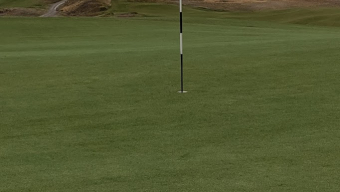UNIVERSITY PLACE, Wa. – The ‘turf war’ is over. The winner is Chambers Bay, poised and ready to seek another championship.
sThe Pierce County-owned links-style course was just 12-year-old this past June yet it already had the distinguished history of hosting two major events, the U.S. Amateur (2010) and the U.S. Open (2015). And yet, without a significant change to the green complexes, there likely would not be another.
Original course designer Robert Trent Jones Jr., believed that the grass throughout the entire complex should be fescue, including the greens. Noble, perhaps, but that idea didn’t hold up, literally. When the world’s best PGA players descended on Chambers in mid-June 2015, the region was already experiencing a rare stretch of exceptionally dry weather. Then the USGA, as is its traditional method, wanted firm, fast and dry conditions to test the best. The result was choking the life out of the greens to the point of compromised play.
Some players groused about the greens conditions, saying it was “like putting on broccoli.’’ Billy Horschel said it was “the worst greens I’ve ever putted on.’’ Ian Poulter called the greens ‘disgraceful.’ Graeme McDowell said the greens barely had a pulse. Gary Players said the course was substandard for an Open venue.
They all attacked USGA President Mike Davis for allowing the greens to deteriorate as badly as they did on the final round. It was a black mark on an otherwise wildly successful event that featured a thrilling victory for Jordan Spieth. He won on the final hole when Dustin Johnson three-putted from 15 feet.
It was an attack that USGA, Pierce County officials and Kemper Sports, Chambers management arm, all conceded and surrendered. The course needed a complete overhaul of all 18 greens to another type of grass.
Matt Allen, Chambers’ vice-president of Operations, said “immediately after the Open’’ all the governing bodies agreed that the issue had to be addressed.
“We needed to accelerate the natural transition,’’ Allen said.
The decision was made to convert the greens from fescue to poa annua, probably the country’s most utilized greens grass. It has its peculiarities, such as some rolling inconsistencies and a bumpy play later in the day. But the players are used to its tendencies and, no doubt, would have preferred poa in 2015.
Chambers, sitting on a bluff overlooking the Sound south of the Narrows Bridge, then purchased poa from Bos Sod Farms in British Columbia, Canada in two installments, one delivered in April last year and one in October. It was planted on the back side of the driving range and moved to the various greens when needed.
Three holes were used a year earlier to test the new surface, No. 7, 10 and 13. The results were positive, so the project got the green light for the other 15 green complexes.
In order to do the project effectively and with cost-efficiency, Kemper had to convince Pierce County officials to close the course for six months, thus severely limiting revenues.
“There was displaced revenue. It would be less profitable. I applaud Pierce County for seeing the long view,’’ Allen said. “We felt it was better to close as quickly as possible, get the sod in the ground and control the overhead.’’
The course re-opened in April and Allen said, “we’ve easily offset the first quarter closure. I think they’re happy with the decision.’’
The reason for the increased play/revenues is because the poa works. Golfers appear to be happy with the results. Their putts are rolling better, more consistently, accurately, and the greens are holding shots better. It’s simply playing better, enhancing the enjoyment factor.
This summer and into the fall will be a transitional period. The sod is settling in. It’s properties still will be revealed as the year advances. The grass will even out its growth. The underlying surface will firm up. Maintenance crews then need to find the optimum cutting height as poa requires a dramatically lower cutting point than fescue.
“The greens are a little soft. We’re sensitive to it,’’ Allen said. “It’s still a links course where the ball is played on the ground to take advantage of contours. We’re not there yet. That’s the challenge for next year, work on firmness and consistency.’’
The greens were the only complaints from the PGA pros. The design, the shaping and the aesthetic views were universally praised. They remain the same. There were no course changes, other than poa all around the green complexes.
The greens will have another year to grow and develop before another significant test, the U.S. Amateur Four-Ball Championship in 2021. It was pushed back a year while the course underwent its change.
“It’s no secret we’re interested in the (LPGA) women’s open,’’ Allen added. “We want another U.S. Open and hope we’re on a path of doing that. But we’re not putting any pressure on it.’’
Chambers folks are working with the USGA on other problem areas, such fan transportation issues and viewing spots, which was a real problem at the Open. Because of nature of the layout, spectators could not get as close to the players as they would have liked and crowd flow was stymied. They are trying to alleviate those issues.
The next Open date would be late in the 2020s. With the greens up to standard and the spectator issues resolved, Chambers hopes to be in line for one. As Allen said, “there’s a feeling like we’ve done everything we can do.’’





















